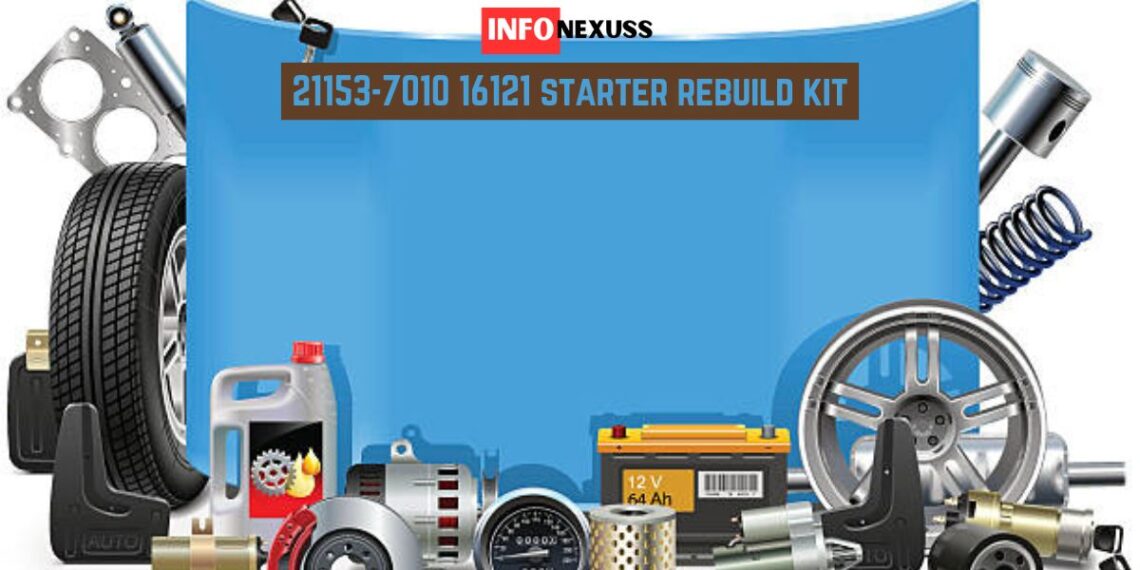
21153-7010 16121 Starter Rebuild Kit: A Comprehensive Guide
Is your lawnmower or other outdoor equipment struggling to start? A faulty starter motor might be the culprit. If you’ve identified the 21153-7010 16121 as the model number for your starter, a rebuild kit can be a cost-effective solution to restore its functionality.
In this guide, we’ll delve into the specifics of this starter rebuild kit, its compatibility, and the steps involved in the rebuilding process. Whether you’re a seasoned DIYer or a novice mechanic, we’ll provide the information you need to tackle this project with confidence.
Understanding the 21153-7010 16121 Starter Rebuild Kit: A Deep Dive
The 21153-7010 16121 starter rebuild kit is specifically designed for certain 19 HP Kawasaki engines. It’s a cost-effective solution to revive a malfunctioning starter motor, offering a sustainable alternative to a complete replacement.
Compatibility: Ensuring a Perfect Fit
To ensure compatibility with your specific engine, it’s crucial to cross-reference the model number. The 21153-7010 16121 starter rebuild kit is designed for 19 HP Kawasaki engines. However, it’s essential to verify the exact model number of your engine to ensure a perfect fit.
You can usually find the engine model number on a sticker or plate attached to the engine itself. If you’re unsure, consulting your owner’s manual or contacting a local equipment dealer can provide additional guidance.
Table of Contents
- 1 Understanding the 21153-7010 16121 Starter Rebuild Kit: A Deep Dive
- 2 Is Rebuilding Your Starter Right for You?
- 3 Where to Find Your 21153-7010 16121 Starter Rebuild Kit
- 4 Replacing Your Starter: A Step-by-Step Guide (for the Adventurous DIYer)
- 5 Conclusion: Empowering Your DIY Spirit with the 21153-7010 16121 Starter Rebuild Kit
What’s Inside the Kit: Essential Components for a Successful Rebuild
The 21153-7010 16121 starter rebuild kit typically includes the following components:
- Brushes: These carbon brushes are responsible for conducting electricity to the armature, enabling the starter motor to rotate. Over time, they can wear down and require replacement.
- Bushings: These are small, cylindrical components that reduce friction between moving parts within the starter motor. Worn bushings can lead to increased resistance and decreased performance.
- Springs: These springs provide tension to the brushes, ensuring proper contact with the commutator. Weak or broken springs can hinder the starter’s ability to engage.
- Other Components: Depending on the specific kit, additional components like bearings or screws may be included.
By replacing these worn components, you can restore your starter motor’s functionality and extend its lifespan.
The Benefits of Rebuilding: Cost-Effective and Environmentally Friendly
Rebuilding your starter motor offers several advantages:
- Cost Savings: Rebuilding is significantly more affordable than purchasing a brand-new starter.
- Environmental Impact: Reusing existing components reduces waste and minimizes the environmental footprint.
- DIY Satisfaction: Repairing your equipment yourself can be a rewarding experience, providing a sense of accomplishment.
However, it’s important to assess your mechanical skills and access to tools and equipment before attempting a rebuild. If you’re unsure about your abilities, consulting a professional mechanic is always a wise choice.
Is Rebuilding Your Starter Right for You?
Before diving into the 21153-7010 16121 starter rebuild kit, it’s crucial to assess your mechanical abilities and the specific issue with your starter.
Assessing Your DIY Skills
Rebuilding a starter motor requires a certain level of mechanical aptitude and access to the right tools. While it’s a rewarding DIY project for many, it might be beyond the capabilities of beginners. If you’re unsure about your skills, it’s advisable to consult a professional mechanic or a repair shop.
Troubleshooting Your Starter
Before jumping into a rebuild, it’s essential to diagnose the exact problem. Here are some common starter issues and troubleshooting steps:
- No-Start Condition:
- Check the Battery: Ensure the battery is fully charged and connected properly.
- Test the Solenoid: Use a multimeter to check if the solenoid is receiving power and engaging the starter motor.
- Slow Cranking:
- Inspect the Starter Motor: Look for signs of damage, corrosion, or excessive wear on the brushes, commutator, or armature.
- Check Battery Connections: Ensure clean and tight connections to prevent voltage drops.
- Clicking Noise:
- Inspect the Solenoid: A clicking noise often indicates a faulty solenoid, preventing the starter motor from engaging.
Learning Resources for DIY Enthusiasts
If you’re confident in your mechanical abilities and want to tackle the rebuild yourself, several resources can help:
- Online Tutorials: YouTube offers numerous videos demonstrating starter motor disassembly, cleaning, and reassembly.
- Repair Manuals: Consult your equipment’s owner’s manual or purchase a specific repair manual for detailed instructions.
- Local Hardware Stores: Seek advice from knowledgeable staff at local hardware stores or automotive parts retailers.
Remember, patience and precision are key when working on delicate components like starter motors. If you encounter any difficulties or uncertainties, don’t hesitate to seek professional assistance.
Where to Find Your 21153-7010 16121 Starter Rebuild Kit
Once you’ve determined that rebuilding your starter motor is the right course of action, the next step is to acquire the necessary parts. The 21153-7010 16121 starter rebuild kit is typically available through various channels:
Online Retailers
- Amazon: As one of the world’s largest online marketplaces, Amazon often carries a wide range of parts, including the 21153-7010 16121 starter rebuild kit. Check their website for availability and pricing.
- eBay: Another popular online marketplace, eBay offers both new and used parts. You may find the 21153-7010 16121 starter rebuild kit or individual components from sellers worldwide.
- Specialized Online Retailers: Websites dedicated to small engine parts and equipment often stock a variety of rebuild kits, including the 21153-7010 16121. These retailers may offer specialized knowledge and support for your specific needs.
Local Retailers
- Small Engine Repair Shops: Local repair shops often carry a range of parts and can assist you in finding the correct kit for your specific engine model. They may also offer expert advice on installation and troubleshooting.
- Hardware Stores: Larger hardware stores with a focus on outdoor equipment might have the 21153-7010 16121 starter rebuild kit or can order it for you.
Tips for Finding the Right Kit:
- Verify Compatibility: Ensure that the kit you purchase is specifically designed for your engine model (19 HP Kawasaki).
- Read Product Reviews: Check customer reviews to get insights into the quality and performance of the kit.
- Compare Prices: Shop around to find the best deal on the 21153-7010 16121 starter rebuild kit.
- Check Shipping Costs: Factor in shipping costs when comparing prices from different retailers.
By following these tips and exploring various online and offline options, you can easily find the 21153-7010 16121 starter rebuild kit and get your equipment up and running again.
Replacing Your Starter: A Step-by-Step Guide (for the Adventurous DIYer)
Disclaimer: Replacing a starter motor can be a complex task. If you’re unsure about your mechanical abilities, it’s recommended to consult a professional mechanic.
Before You Begin:
- Safety First: Disconnect the battery to prevent accidental starts.
- Gather Tools: Prepare basic tools like screwdrivers, wrenches, and possibly a drill to remove stubborn bolts.
- Prepare Your Workspace: A clean, well-lit workspace will make the job easier.
Step-by-Step Replacement Process:
- Access the Starter:
- Locate the starter motor on your engine. It’s typically attached to the engine block and connected to the flywheel.
- Remove any shrouds or covers that may obstruct access.
- Disconnect Electrical Connections:
- Carefully disconnect the electrical connectors from the starter motor. Take note of the connections to ensure proper reassembly.
- Remove the Starter Bolts:
- Use a wrench or socket wrench to loosen and remove the bolts securing the starter motor to the engine block.
- Disconnect the Starter from the Flywheel:
- Carefully remove the starter motor from the flywheel. You may need to use a pry bar or a starter removal tool to help disengage the starter gear from the flywheel.
- Disassemble the Starter Motor:
- Once removed, disassemble the starter motor by removing the housing cover and other components.
- Replace the worn-out components with the new parts from your 21153-7010 16121 starter rebuild kit.
- Reassemble the Starter Motor:
- Carefully reassemble the starter motor, ensuring all components are properly aligned and tightened.
- Install the Rebuilt Starter:
- Reattach the starter motor to the engine block, ensuring proper alignment and tightening the bolts securely.
- Reconnect the electrical connectors, making sure they are securely fastened.
- Test the Starter:
- Reconnect the battery and attempt to start the engine. Listen for any unusual noises or vibrations.
Safety Precautions:
- Wear Protective Gear: Always wear safety glasses and gloves to protect your eyes and hands.
- Battery Safety: Disconnect the battery before working on the starter motor to prevent accidental starts.
- Tool Safety: Use appropriate tools and ensure they are in good working condition.
- Avoid Force: If you encounter resistance during disassembly or reassembly, stop and reassess the situation. Excessive force can damage components.
Remember, this is a general guide, and specific procedures may vary depending on your engine model and the exact components included in your 21153-7010 16121 starter rebuild kit. Always consult your equipment’s manual or seek professional advice if you have any doubts.
Also Read: Unveiling Power of Google Business Profile KGmid Extractor
Conclusion: Empowering Your DIY Spirit with the 21153-7010 16121 Starter Rebuild Kit
By understanding the intricacies of the 21153-7010 16121 starter rebuild kit, you’ve taken a significant step towards reviving your outdoor equipment. Remember, while rebuilding your starter motor can be a rewarding DIY project, it requires patience, precision, and a certain level of mechanical aptitude.
If you’re unsure about your abilities or encounter any difficulties, don’t hesitate to seek professional help. A qualified mechanic can provide expert assistance and ensure a successful repair.
Key Takeaways:
- Compatibility is Key: Verify that the 21153-7010 16121 starter rebuild kit is compatible with your specific engine model.
- Understand the Components: Familiarize yourself with the components included in the kit and their functions.
- Safety First: Prioritize safety by disconnecting the battery and wearing protective gear.
- Take Your Time: Rushing the process can lead to mistakes and damage.
- Seek Professional Help if Needed: Don’t hesitate to consult a mechanic if you encounter any difficulties.
By following these guidelines and leveraging the information provided in this guide, you can successfully rebuild your starter motor and save money while gaining valuable DIY skills.
We encourage you to share your experiences with the 21153-7010 16121 starter rebuild kit in the comments below. Your insights can help other DIY enthusiasts.
For more tips and tricks on lawnmower maintenance and repair, check out our other articles.
You May Also Like

What is https// gamemakerblog.net and Why Does it Matter?
October 25, 2024Crossovericon.eu: Your Gateway to Epic Crossover Merchandise
May 12, 2024

